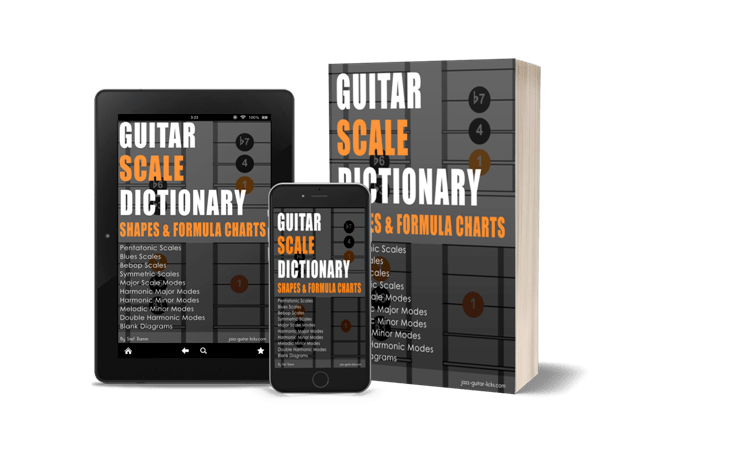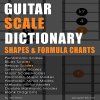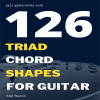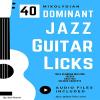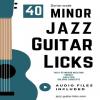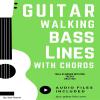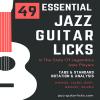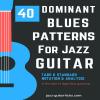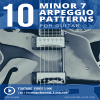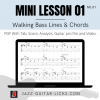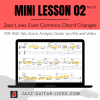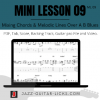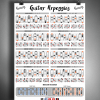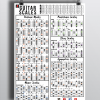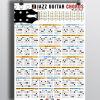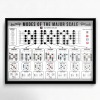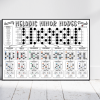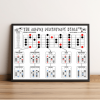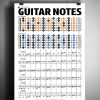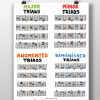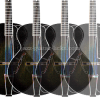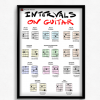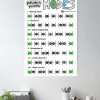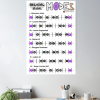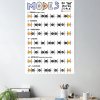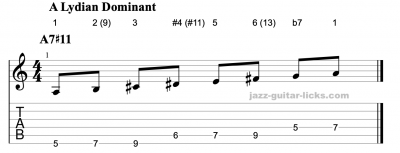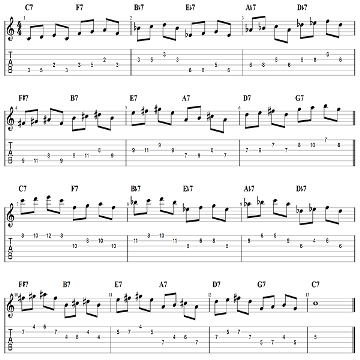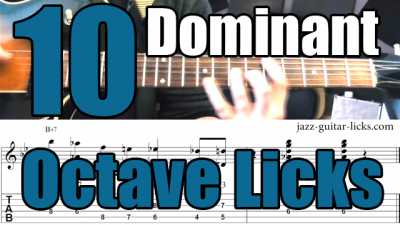
Dominant, Subdominant, Secondary Subdominant and Secondary Dominant Chords - Guitar Theory Lesson
- By jazz-guitar-licks
- On 2023-07-30
- 0 comments
In music theory, the terms "dominant," "subdominant," and "secondary dominant" are used to describe different types of chords and their functions within a key or harmonic progression.
Here's an explanation of each term with examples for guitar players.
Harmonization Of The Main Types Of Scales
Before learning the difference between "dominant," "subdominant," and "secondary dominant" you need to know how to harmonize the main types of scales.
Theses charts represent the harmonization of a specific scale (such as the major scale, natural minor scale, harmonic minor scale, or melodic minor scale) with seventh chords.
Each row in the chart corresponds to a degree of the scale and provides information about the chord built on that degree.
- The "Degree" column indicates the degree of the scale, using Roman numerals (I, II, III, IV, V, VI, VII), in upper case for major and lower case for minor.
- The "Name" column provides the commonly used name for that degree, such as "Tonic," "Supertonic," "Mediant," and so on.
- The "Chord" column specifies the seventh chord built on that degree, indicating the root note and the chord type, such as "A minor 7," "B diminished 7," or "C Major 7."
- The "Seventh Chord Formula" column lists the intervals that make up the chord, relative to the root note. The formula consists of numbers representing the interval steps, such as "1," "3," "5," and "7."
The lowercase letter "b" signifies a lowered or flattened note, and the "#" or "aug" symbol represents a raised or augmented note. The "bb" symbolizes a double-flattened note. To get the triad formula, just remove the "7".
By following the chord formulas in the chart, you can harmonize a given scale by building seventh chords on each degree of the scale.
This allows you to explore and understand the chord progression and harmonic possibilities within that particular scale.
Chords Of The Major Scale
| Degree | Name | Chord | Seventh Chord Formula |
|---|---|---|---|
| I | Tonic | C Major 7 | 1 3 5 7 |
| ii | Supertonic | D minor 7 | 1 b3 5 b7 |
| iii | Mediant | E minor 7 | 1 b3 5 b7 |
| IV | Subdominant | F Major 7 | 1 3 5 7 |
| V | Dominant | G7 | 1 3 5 b7 |
| vi | Submediant | A minor 7 | 1 b3 5 b7 |
| vii° | Leading Tone | B half-diminished | 1 b3 b5 b7 |
Chords Of The Natural Minor Scale
| Degree | Name | Chord | Seventh Chord Formula |
|---|---|---|---|
| i | Tonic | A minor 7 | 1 b3 5 b7 |
| ii° | Supertonic | B half-diminished | 1 b3 b5 b7 |
| III | Mediant | C Major 7 | 1 3 5 7 |
| iv | Subdominant | D minor 7 | 1 b3 5 b7 |
| v | Dominant | E minor 7 | 1 b3 5 b7 |
| VI | Submediant | F Major 7 | 1 3 5 7 |
| VII | Subtonic | G7 | 1 3 5 b7 |
Chords Of The Harmonic Minor Scale
| Degree | Name | Chord | Seventh Chord Formula |
|---|---|---|---|
| i | Tonic | A minor(maj7) | 1 b3 5 7 |
| ii° | Supertonic | B half-diminished | 1 b3 b5 b7 |
| III+ | Mediant | Cmaj7#5 | 1 3 #5 7 |
| iv | Subdominant | D minor 7 | 1 b3 5 b7 |
| V | Dominant | E7 | 1 3 5 b7 |
| VI | Submediant | F Major 7 | 1 3 5 7 |
| vii° | Leading Tone | G# diminished 7 | 1 b3 b5 bb7 |
Chords Of The Melodic Minor Scale
| Degree | Name | Chord | Seventh Chord Formula |
|---|---|---|---|
| i | Tonic | A minor(maj7) | 1 b3 5 7 |
| ii | Supertonic | B minor7 | 1 b3 5 b7 |
| III+ | Mediant | C maj7#5 | 1 3 #5 7 |
| IV | Subdominant | D7 | 1 3 5 b7 |
| V | Dominant | E7 | 1 3 5 b7 |
| vi° | Submediant | F# half-diminished | 1 b3 b5 b7 |
| vii° | Leading Tone | G# half-diminished | 1 b3 b5 b7 |

Difference Between Dominant, Subdominant, and Secondary Dominant.
Dominant Chords
In a major or minor key, the dominant chord (or dominant 7 chord) is built on the fifth degree of the scale. It is often represented by the Roman numeral V (Upper case "V" for major, lower case "v" for minor).
In a major key, the dominant chord is usually a major triad (e.g., G major in the key of C major). When adding the 7th to this triad we get a dominant 7 chord (e.g G7 in the key of C).
It is the same for the harmonic minor and melodic minor scales, the dominant chord is a also a major triad (or a dominant seventh chord).
In a minor key (natural), it is typically a minor triad (e.g., E minor in the key of A minor), just add the b7 to get a minor 7 chord.
The dominant chord has a strong tendency to resolve to the tonic chord (the chord built on the first degree of the scale) and is often used to create tension and drive within a musical phrase or progression.
Here are some examples:
Dominant 7 Within Major 2 5 1
One classic example of a jazz chord progression that includes dominant 7th chords is the ii-V-I progression. In the key of C major, the ii-V-I progression would consist of the following chords:
Dm7 (iim7) - G7 (V7) - Cmaj7 (Imaj7)
Here, the G9 chord is the dominant chord. This progression is commonly used in jazz and provides a sense of tension and resolution. The dominant
chord (G7) creates tension that resolves to the tonic chord (Cmaj7).

You can experiment with different voicings and variations of the chords to add your own flavor and style to the progression.
Dominant 7 Within Minor 2 5 1
Dominant 7th chords can also be used in minor progressions, example with a ii-V-I sequence in the key of A minor:
Bm7b5 (iiø) - E7(b9) (V7) - Am7 (im7)
In this case, the E7(b9) chord is the dominantchord (in harmonic minor and melodic minor scales). The Bm7b5 chord functions as the ii chord in the A minor key, leading to the dominant E7 chord, which then resolves to the tonic Am chord. Notice that the dominant 7th chord is commonly altered with the b9, b13.

Similarly to major progressions, you can explore different voicings, substitutions, and alterations to create your own unique sound within the minor ii-V-I progression.
Dominant 7 In Basic Blues
Basic blues progressions exclusively features dominant-type chords. It means that when constructing basic blues chord progressions, the tonic (I7), subdominant (IV7), and naturally, the dominant (V7) chords are all of the dominant type, characterized by the notes 1, 3, 5, and b7. Here is an example in Bb :

Dominant Chord In Minor (Natural) Keys
In natural minor scales, the fifth scale degree is a minor chord. Therefore, the term "minor dominant chord" can be a bit misleading.
When transitioning from a minor v chord to a minor i chord, it doesn't create the same level of tension as the transition from a major triad or dominant V chord would produce. That's why it is common to replace the v chord by a major triad or dominant 7th chord as it is the case in melodic and harmonic minor scales.
Here are some examples of minor progressions including dominant chords.
Example 1 : im7 v7 im7 (Am7 Em7 Am7)
In this first example the dominant chord is minor (Em7) .

Example 2 : im7 V7 im7 (Am7 E7 Am7)
This one is the same as the previous but with a dominant 7 chord (E7) instead of the minor dominant.

Example 3 : im7 V7 ivm7 VII7 IIImaj7 V7 im7 (Amin7 – E7 – Dmin7 – G7 – Cmaj7 – E7 – Amin7)
Here is a longer progression in Am including a dominant 7 chord as the V instead of a minor 7.

Example 4 : i – #idim7 – iiø – V7 (Am – A#dim7 – Bø – E7)
This contains one passing chord (A#dim7) to create a smooth transition (voice leading) between the im7 and iim7b5.

Subdominant Chords
In basic theory, the subdominant chord is built on the fourth degree of the scale and is commonly represented by the Roman numeral IV. (Upper case "IV" for major, lower case "iv" for minor).
In major keys, the subdominant chord is typically a major triad (e.g., F major in the key of C major), while in minor keys, it is usually a minor triad (e.g., D minor in the key of A minor), except for the melodic minor scale where it is a major triad.
The subdominant chord provides a sense of stability and is often used as a contrast to the dominant chord. It frequently precedes the dominant chord in progressions and can create a feeling of anticipation or preparation for the resolution to the tonic.
| Major Scale | Subdominant Seventh (IV7) Chord | Chord Symbol | Notes in the Chord |
|---|---|---|---|
| C major | F7 | F7 | F - A - C - Eb |
| C# major | F#7 | F#7 | F# - A# - C# - E |
| D major | G7 | G7 | G - B - D - F |
| Eb major | Ab7 | Ab7 | Ab - C - Eb - G |
| E major | A7 | A7 | A - C# - E - G |
| F major | Bb7 | Bb7 | Bb - D - F - Ab |
| F# major | B7 | B7 | B - D# - F# - A# |
| G major | C7 | C7 | C - E - G - Bb |
| Ab major | Db7 | Db7 | Db - F - Ab - C |
| A major | D7 | D7 | D - F# - A - C |
| Bb major | Eb7 | Eb7 | Eb - G - Bb - D |
| B major | E7 | E7 | E - G# - B - D# |
Subdominant Chords In Jazz
In jazz, the subdominant chord is more commonly the ii chord (built on the second degree of a major scale) and less commonly the vi chord. Jazz musicians refer to this as the "subdominant" since it combines the subdominant and supertonic elements.
By using the ii7 chord, which is derived from the supertonic degree of the major scale, jazz musicians introduce more chromatic movement and a stronger pull towards the dominant chord. This progression, such as ii7 - V7 - I, is a common jazz cadence.
You'll find several examples with tabs and audio files in this serie of PDF methods for guitarists.
The following chart show the iim7 and V7 chords in all twelve keys.
| Major Key | ii minor seventh (iim7) Chord | Dominant seventh (V7) Chord |
|---|---|---|
| C major | Dm7 | G7 |
| C# major | D#m7 | G#7 |
| D major | Em7 | A7 |
| Eb major | Fm7 | Ab7 |
| E major | F#m7 | B7 |
| F major | Gm7 | C7 |
| F# major | G#m7 | C#7 |
| G major | Am7 | D7 |
| Ab major | Bbm7 | Eb7 |
| A major | Bm7 | E7 |
| Bb major | Cm7 | F7 |
| B major | C#m7 | F#7 |
Secondary Dominant Chords
A secondary dominant chord (or a dominant approach chord) is a chord that temporarily functions as the dominant of a chord other than the tonic. It is is used to tonicize the chord you are moving to, create additional tension and harmonic interest.
A secondary dominant is built on a scale degree other than the fifth and is represented by the Roman numerals V/V, V/ii, V/iii, etc., where the number after the slash indicates the degree of the temporary tonic.
For example, in the key of C major, the dominant chord of the dominant (V/V) is D major (D, F#, A), and the dominant chord of the relative minor (V/vi) is E major (E, G#, B).
Secondary dominants are commonly used in progressions to modulate to different keys or to create chromatic harmonies. Remember that any chord can be preceded by its secondary dominant.
Here is a recapitulative chart showing the secondary dominant of each chord of the diatonic major scale.
| Chord | Roman Numeral | Secondary Dominant | Roman Numeral of Secondary Dominant |
|---|---|---|---|
| Cmaj7 | I | - | |
| Dm7 | ii | A7 | V7/ii |
| Em7 | iii | B7 | V7/iii |
| Fmaj7 | IV | C7 | V7/IV |
| G7 | V | D7 | V7/V |
| Am7 | vi | E7 | V7/vi |
| Bm7b5 | vii° | F7 | V7/vii° |
Secondary Dominant In Major 1 6 2 5
Here you can hear A7 the secondary dominant (V/ii) of the iim chord (Dm9).

Secondary Dominant Chord Substitution
Here is another possibility of secondary dominant chord borrowed from the harmonic minor scale (degree VII). In the example, C#dim7 is a substitute for the A7(b9) the secondary dominant chord of Dm7.

Major Scale Chords And Secondary Dominants
In the following exercise, you can hear the chords of the C major scale (descending) and their secondary dominant chords. Notice the viiø chord (Bm7b5) has been voluntarily omitted.

Major Scale, Secondary dominants And Secondary Subdominants
Here is the same progression with secondary subdominant chords added. Even if the therm of secondary subdominant is debatable (some theorist just call them "short modulation), the result is the same, they have the function of II of.... as shown in the example below.

To summarize, the dominant chord is built on the fifth degree of the scale and has a strong tendency to resolve to the tonic. The subdominant chord is built on the fourth degree (or second in jazz theory) and provides stability and contrast.
Secondary dominant chords temporarily act as dominants for chords other than the tonic, adding tension and harmonic complexity to a progression.
-
Guitar Chord Dictionary
This PDF eBook provides over 550 guitar chord shapes. This is the perfect reference guide to understand how chords are built and how to play them on the guitar neck. -
Guitar Scale Dictionary
This E-book is a printable PDF method including over 700 scale diagrams and formula charts for guitarists. -
Harmonized Scales For Guitar
Complete guitar PDF on harmonized scales: major, minor, harmonic and melodic. Includes chord and arpeggio diagrams, charts and practical tabs. -
172 Arpeggio Shapes For Guitar
This printable PDF is a method dedicated to guitarists of all styles who want to learn build and play the most important types of arpeggios. -
126 Triad Chord Shapes
This handbook for guitar players is intended both for teachers and students. It includes 126 guitar shapes for mastering triads. -
Harmonic Major Scale Chords
this PDF offers diagrams and tabs for guitar to learn the chords of the harmonic major scale. -
Major Scale Harmonization
This package provides a printable PDF with exercises and audio files to learn how to harmonize the major scale with 3 note chords and their extensions. -
30 Minor Arpeggio Licks
This package includes a printable PDF method containing 30 exercises with tabs, staves and audio files for practicing minor arpeggios on guitar. -
II V I Bundle - 170 Exercises
This bundle contains 4 PDF methods for a total of 170 exercises with tabs, staves, analysis & audio files for practicing scales, arpeggios licks & chords over the 2-5-1 progression. -
Diatonic Licks Bundle
This package contains 120 jazz guitar lines based on diatonic modes as Mixolydian, Dorian and Ionian. PDF format with tabs, audio files and analysis. -
30 Groovy Jazz Guitar Licks
This downloadable package contains a PDF WITH audio files giving access to 30 groovy guitar phrases mixing jazz, blues and funky licks for beginners. -
30 Smooth Jazz Guitar Licks
In this package you'll get a printable PDF Method with tabs, notation, analysis, scale shapes and audio files for practicing 30 smooth jazz guitar licks. -
40 II V I Jazz Guitar Licks
This pdf method for guitar contains fourteen 2 5 1 jazz guitar lines with tab, standard notation, analysis, scale charts and audio files. -
50 II-V-I voicings
This printable PDF guitar method provides 50 exercises with audio files, analysis, tab and staves for learning major 2-5-1 chord voicings. -
40 Minor 2 5 1 Chord Voicings
This PDF method contains 40 exercices with tabs, scores and audio files for practicing jazz guitar chords over the minor 2 5 1 progression. -
40 Minor II V I Licks
This guitar method is a printable PDF with tabs, diagrams, theory and audio files providing 40 minor 2 5 1 jazz patterns. -
40 Mixolydian Jazz Guitar Lick
PDF guitar method with tabs, audio files and theory providing 40 dominant jazz guitar lines for teachers and students. -
40 Minor Jazz Guitar Licks
This printable guitar method in PDF format contains 40 easy minor jazz guitar lines based on the Dorian mode. -
40 Major Jazz Guitar Licks
Printable PDF eBook method containing 40 major jazz guitar licks with tab, standard notation and audio files for beginners and intermediates. -
Guitar Walking Bass Lines
This jazz guitar method about walking bass lines and chords is available as a PDF files containing 35 exercises with tabs, analysis and audio files -
101 Dominant Arpeggio Patterns
This printable PDF method provides 101 dominant arpeggio exercises with tab, theory and standard notation for the jazz, blues and rock guitarist. -
49 Essential Jazz Lines
This printable eBook method in PDF format provides 49 jazz solo transcriptions of the greatest jazz musicians. Tab, standard notation, audio files & analysis. -
11 Jazz Blues Studies
11 jazz blues chord studies with tabs, standard notation, analysis, and audio recordings and PDF. -
10 Easy Fingerstyle Blues
This PDF with Tabs and audio files provides 10 easy acoustic fingerstyle blues guitar studies for kids and beginners. -
25 Altered Jazz Guitar Lines
This PDF eBook method contains 25 altered jazz guitar licks with tabs, patterns, scale charts and audio files to master, apply and develop the altered scale. -
40 Blues Dominant Patterns
This printable method is available as a PDF file containing 40 easy dominant jazz-blues guitar lines with tabs, standard notation, analysis, audio files and scale charts. -
25 Pentatonic Licks
This jazz guitar method is an eBook available as a PDF with standard notation, guitar tabs, diagrams, analysis, audio files and backing tracks. You will find in this booklet 25 easy jazz guitar lines with theory using common and rare pentatonic scales. -
25 Soul Jazz Guitar Licks
You will find here an eBook available in PDF containing 25 soul jazz and hard bop guitar licks in the style of Grant Green, Melvin Sparks, George Benson. -
25 Diminished Patterns
This eBook PDF with audio files contains 25 dominant diminished jazz guitar patterns using the half-whole diminished scale and diminished 7th arpeggios. -
6 Tritone substitution licks
This Printable PDF eBook available for free download contains 6 easy jazz guitar licks with tabs/notation, youtube video link and analysis about the tritone substitution. -
10 Minor 7 Arpeggio Patterns
This printable PDF eBook offers 10 easy minor 7 arpeggio patterns with its related YouTube video for beginner guitarists. -
10 Easy Major 7 Arpeggio Licks
This is a printable PDF for beginner jazz guitar players providing 10 easy licks to practice major 7 arpeggios. -
10 Chord Melody Lines
Within this package, you'll discover a set of ten chord melody exercises for beginners. Printable PDFaudio files, a backing track, and a link to the associated YouTube video. -
10 Minor Blues Scale Licks
You'll find here a PDF with 10 easy jazz guitar licks to practice the minor blues scale on guitar.
-
Mini Lesson 01 (ML 01)
You'll find a mini guitar lesson about walking bass lines and chords containing a PDF with tab, score analysis, shapes, a video and a guitar pro file. -
Mini Lesson 02 (ML 02)
In this mini jazz guitar lesson you will learn how to play easy and cool jazz lines over basic chord changes found in jazz. Pdf, tab and video included. -
Mini Lesson 03 (ML 03)
With this short lesson you will learn how to play and connect basic guitar arpeggios over a diatonic chord progression. -
Mini Lesson 04 (ML 04)
This is a downloadable package with PDF, Tab, guitar pro file and video to practice guitar arpeggios over a jazz blues chord progression. -
Mini Lesson 05 (ML 05)
This downloadable package provides a PDF with Tab/score, a guitar pro file and a short video for practicing guitar arpeggios on a jazz blues progression in Bb. -
Mini Lesson 06 (ML 06)
This package for guitarists contains a PDF with tab, video, backing track and guitar pro file for practicing arpeggios over a basic jazz blues progression. -
Mini Lesson 07 (ML 07)
With this mini guitar lesson you will learn how to superimpose arpeggios over a diatonic chord progression. Video, pdf, jamtrack and guitar pro file included. -
Mini Lesson 08 (ML08)
Mini lesson with PDF, guitar pro file, video and backing track for practicing scale and arpeggio connections over a Bb jazz blues progression. -
Mini Lesson 09 (ML09)
This mini lesson is a downloadable package containing a PDF, video, backing track and guitar pro file of a jazz blues progression study in B. -
Mini Lesson 10 (ML 10)
This mini guitar lesson provides a printable PDF with tab/notation, video, backing track and guitar pro file for practicing open triads over Fly Me To The Moon. -
Mini Lesson 11 (ML 11)
This guitar lesson is a package inlcuding a PDF transcription with analysis, a short video, a backing track and a guitar pro file to learn to play jazz solo lines over Blue Bossa. -
Jazz Blues Guitar Study (ML12)
This mini lesson provides a video, a guitar pro file and PDF transcription of a jazz blues study in G implying melodic lines, chord extensions and substitutions
-
Guitar Arpeggios Poster
This giant guitar poster for any guitar player, student or instructor contains colorful arpeggio diagrams. Giant size 24 x 36 inches (60 x 90 cm). -
Guitar Scales Poster 24*36
Guitar posters and wall art with eighteen neck diagrams representing the most used scales in music. -
Guitar Chord Poster
This printed color posters contains 63 guitar chord diagrams for jazz players, students, teachers and schools. -
Guitar Modes Poster
Guitar reference posters and wall art about modes of the major scale for guitar teachers, students and music schools. -
Melodic Minor Modes Poster
Educative and decorative giant guitar poster with neck diagrams, interval names about the seven modes of the melodic minor scale. -
Pentatonic Scale Guitar Poster
This guitar reference poster shows the positions and intervals of the major pentatonic scale. -
Guitar Notes Poster
This is a giant poster showing the notes on the guitar fret board and their positions on a musical staff. -
Triads Guitar Poster
This reference poster show the positions and intervals of the main triads used on guitar. This is a useful tool for guitarists, teacher and students. -
Four Archtop Guitars Poster
This is a decorative poster with four archtop jazz guitars. Several size and colors in landscape format available on Teespring and redbubble. -
Intervals On Guitar - Poster
This giant poster for guitar provides neck diagrams with interval positions. -
Melodic Minor Modes
This music theory poster available in several sizes shows the construction of the seven modes of the melodic minor scale. -
Major Scale Chords
This handy poster provides a clear visual guide to the chords built from the major scale, helping you recognize patterns and improve your playing. -
Melodic Minor Chords
Explore the rich harmonic possibilities of the melodic minor scale with this essential guitar poster. -
Harmonic Minor Modes
This music theory poster, offered in various sizes, demonstrates the structure of the seven modes of the melodic minor scale. -
Harmonic Minor Chords
Discover the chords of the harmonic minor scale with this guitar poster. -
Major Scale Modes
This poster is created for music teachers and students, illustrating the structure of the seven modes of the major scale.
dominant Subdominant secondary subdominants Secondary Dominant Chords Guitar Theory Lesson guitar chords harmony guitar scales major scale melodic minor harmonic minor minor scale
Add a comment

